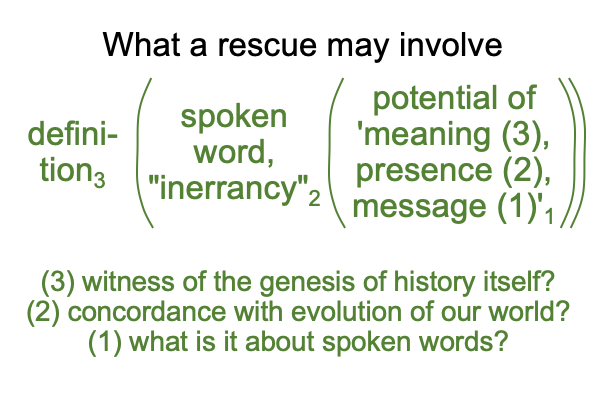0023 The category-based nested form for the actuality of the spoken term, “Biblical inerrancy”, comports with Ross’s introductory argument. At the same time, it does not.
Ross portrays a theodrama where a conclave of Protestant theologians meet in Chicago and set a standard. Later, theologians start to compromise in the face of deniers.
He extends the theodrama to include the past few centuries.
0024 To this examiner, the theodrama is much older. The separation of… what?… what the modern theologians will affirm… and what the modern theologians will deny…. has a mytho-history. And, this now-esoteric theodramatic development is very much in evidence during the thirteenth century, the saeculorum when Saint Thomas Aquinas “baptized” the philosophy of Aristotle, whose writings had just been looted from Islamic jurisdictions by Christian Crusaders.
Or, were Aristotle’s writings “liberated”?
0025 Hmmm, before I go there, I want to dwell of the other key word in Ross’s title: “rescue”.
Here is a picture of what rescuing Biblical inerrancy may involve.

0026 As for meaning, Genesis 1-11 serves as an honest witness to the start of our world and our current Lebenswelt. Obviously, these are not the same. There is a disjuncture between Genesis 2.3, where the Creation Story closes, and Genesis 2.4, where the Primeval History begins.
Whoa! “Primeval history” labels Genesis 1-11. Doesn’t it?
Not in this examination.
Here, the Creation Story is Genesis:1 to 2.3. The Primeval History is Genesis:2.4 to 11.
Keep that terminology in mind.
It plays a part in any rescue.
0027 As for presence, the Creation Story is a sign of the evolutionary record. Ross does not fully articulate that concept in this book. But, what Ross calls “moderate concordism” sounds like presence to me. Just as Hamlet presents his play to the court in order to raise the awareness of one member of the audience, the person who killed his father, so God presents the Creation Story in order to raise the consciousness of a particular audience in our modern theodrama, the deniers.
Who could have imagined?
What crimes are the deniers guilty of?
I hope that they are not anything like the crimes committed by Adam and Eve.
0028 Finally, in regards to message, I have to ask, “What is it about spoken words?”
In the Creation Story, God speaks and nature (which is not God) constructs a reality that manifests God’s words.
In the Primeval History, there is a serpent with no hands, who speaks in such a way as to completely fool poor Eve, who walks right into a legal trap.
Oh, Eve will not “die”, because that is not how the serpent defines the word, “to die”. In fact, the serpent has all sorts of alternate definitions to apply to the act of eating fruit from the tree of the knowledge of good and evil. None of them carry the suggestion that Eve keep the seed of that fruit in order to plant it outside of Eden, once she and Adam get tossed off the premises.
0029 It makes me wonder whether that is precisely what Eve does.
Okay, I admit, Ross does not go there.
Instead, the title says it all: Rescuing Inerrancy: A Scientific Defense.
I ask, “What does the spoken word, ‘inerrancy’ mean? Why does it need to be ‘rescued’? What does a ‘scientific defense’ entail?”
0030 In our postmodern world, the titular terms and my list of questions entail explicit abstraction. “Inerrancy”, “rescue” and “scientific defense” are terms that hand-talking ancestral hominins could never sign… or manual-brachial word-gesture. Why? What is there to picture or point to?
Hand-talk words picture and point to their referents. So, the meaning, the presence and the message of a manual-brachial word-gesture involves implicit abstraction. The referent is implicit to the gesture-word. The referent is what the gesture-word pictures or points to.
That is not the case with speech-alone talk.
Spoken words cannot picture or point to anything.
